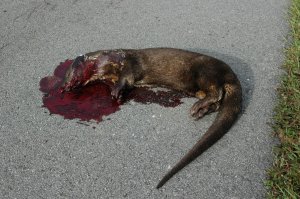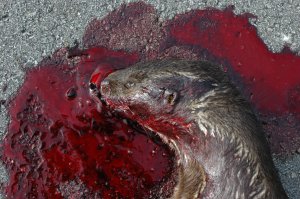IUCN/SSC Otter Specialist Group Bulletin

|
©IUCN/SCC Otter Specialist Group Volume 32 Issue 1 (January 2015) Citation: Tan, H.H. (2015). A Roadkill Record of a Hairy-Nosed Otter (Lutra sumatrana) from Selangor, Peninsular Malaysia IUCN Otter Spec. Group Bull. 32 (1): 8 - 11 A Roadkill Record of a Hairy-Nosed Otter (Lutra sumatrana) from Selangor, Peninsular Malaysia Heok Hui Tan1 1Lee Kong Chian Natural History Museum, National University of Singapore, Kent Ridge, Singapore. Email:nhmthh@nus.edu.sg |

|
| Received 20th November 2013, accepted 2nd January 2015 |
| Abstract: A fresh hairy-nosed otter roadkill was encountered along the Tanjung Malim-Sungei Besar Road in northern Selangor (Malaysia) in 2005. This appears to be the first fresh record of this elusive species from Selangor since 1929. |
| Keywords: Selangor, peat swamp forest, incidental road kill, Lutra sumatrana |
| Française | Español |
INTRODUCTION
The hairy-nosed otter (Lutra sumatrana) is an elusive and rarely encountered animal throughout its native range in Southeast Asia (Wright et al., 2008). Within Peninsular Malaysia, formal records and published sightings of L. sumatrana had been recorded from areas close to aquatic habitats (e.g. peat swamps, forested riverine environments) in Perak and Pahang (Sebastian, 1995) and most recently in Taman Negara, Pahang (Baker, 2013).
DETAILS OF SIGHTING
On the morning of the 5th January 2005 around 0900 hrs, the author was travelling along the Tanjung Malim to Sungei Besar road, cutting through the remnant North Selangor peat swamp forest (Figure 1). At around mile stone km 41 to Sungei Besar, two dark forms were sighted along the road on a gentle bend. As the vehicle approached closer one dark form disappeared into the roadside vegetation, leaving the remaining dark form on the road. The vehicle was stopped and the author alighted to check the situation. The prone form turned out to be a recent incidental road kill of an otter, of about 1.2 metres in length, with a large pool of fresh semi-coagulated blood pool around the anterior half (Figure 2-3).
 |
| Figure 1. Map of Peninsular Malaysia showing the approximate location (black square) of the road kill sighting. (click for larger version) |
The freshly dead road kill appeared to be a female hairy-nosed otter, as there was no visible sign of testicles between the base of the hind limbs near the anus. It had a hairy rhinarium, though the diagnostic pale lips, chin and neck region were largely obscured by blood; plus a flattened lateral profile of the head. The identity was verified later by a check using Payne & Francis, 1985; Kanchanasakha et al., 1998; Francis, 2008, and personal communications with Yong D. C. G., Lim K. K. P. and Sivasothi N. (2005).
The site of the road kill is less than four meters away from the nearest water source, a black water creek running parallel to the road, at the edge of remnant peat swamp forest. As the pelage on the otter appears to be wet, it could be that the otter was run over while recently out of the creek. This remnant forest had been degraded, as large sections had been converted to oil palm plantations. The other otter which had earlier moved off was probably an offspring or its mate, but had remained nearby its fallen counterpart.
DISCUSSION
This appears to be the first fresh record of Lutra sumatrana in Selangor since 1929. There is a skull deposited in the Zoological Reference Collection (of the Lee Kong Chian Natural History Museum) of a male L. sumatrana (ZRC 4.1231), collected from 7th mile Cheras in Selangor dated 1929. However, the unfortunate circumstances highlight the conflict between anthropogenic influences vs. wildlife. As intact forests (in this case, peat swamp forest) get fragmented, wildlife gets displaced and is forced into situations where natural passage ways are attenuated and fatal situations typically occur for wildlife.
Since 2005, the author had been back to the same area twice and the situation had deteriorated even more. The black water creek has had been replaced by a man-made ditch draining the remnant swamp, the peat swamp forest patches have been further fragmented, and the area for oil palm plantations had increased.
Acknowledgements - Thanks to Dennis Yong for driving and initial identification. Kelvin Lim (Lee Kong Chian Natural History Museum, NUS) and N. Sivasothi (Department of Biological Sciences, NUS), for verifying the identity of the otter. Kelvin Lim, for encouraging me to publish this report due to the rarity of the otter.
REFERENCES
Baker, N. 2013. New records of hairy-nosed otter (Lutra sumatrana) in Peninsular Malaysia. IUCN Otter Spec. Group Bull. 30 (2): 112-118.
Francis C.M. 2008. A Field Guide to the Mammals of South-East Asia. New Holland Publishers (UK) Ltd. 392 pp.
Kanchanasakha, B., Simcharoen, S., Than, U.T. 1998. Carnivores of Mainland South-East Asia. WWF Thailand. 236 pp.
Payne, J., Francis, C.M. 1985. A Field Guide to the Mammals of Borneo. The Sabah Society with World Wildlife Fund Malaysia. 332 pp.
Sebastian, A. 1995. The hairy-nosed otter in Peninsular Malaysia. IUCN Otter Special. Group Bull. 11: 3.
Wright, L., Olsson, A., Kanchanansaka, B. 2008. A working review of the hairy-nosed otter (Lutra sumatrana). IUCN Otter Spec. Group Bull. 25 (1): 38-59.
Résumé : Enregistrement d'Une Loutre de Sumatrana (Lutra sumatrana) ecrasee au Selangor dans la Peninsule Malaisienne.
Une Loutre de sumatrana fraichement écrasée a été trouvée le long de la route Tanjung Malim-Sungei Besar dans le Nord du Selangor en 2005, en Malaisie. Cela constitue être le premier enregistrement récent de cette espèce insaisissable au Selangor depuis 1929.
Revenez au dessus
Resumen: Registro de Una Nutria de Sumatra (Lutra sumatrana) Atropellada, en Selangor, Península Malaya
Se encontró una nutria sumatrana recién atropellada, en la Ruta Tanjung Malim-Sungei Besar, en el norte de Selangor (Malasia) en 2005. Parece ser el primer registro actual de esta elusiva especie en Selangor, desde 1929.
Vuelva a la tapa

